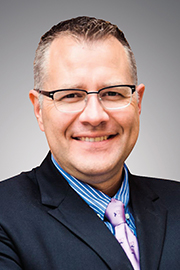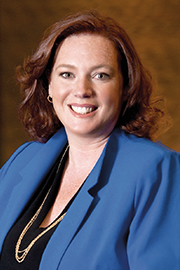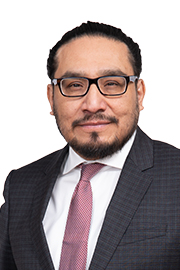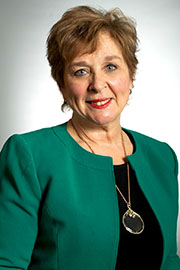- May/10/23 3:50:00 p.m.
I think that’s a great question, but I don’t think I’m the person to answer that question, actually, because if there’s one thing I’ve learned in working with Indigenous people, it’s the idea of the two-row wampum, for those who know what it is—the Hiawatha Belt, as it’s also called. It was actually made with Dutch settlers to New York 400 years ago. It was the idea of two nations walking side by side in perpetuity without mixing each other up.
We have spent hundreds of years destroying that belt, tearing it to pieces and scattering those beads all over the place. But with a project like this, I believe we have an opportunity to knit those pieces back together. We owe that to the people who were here before us. I really look forward to hearing the input on how this could be a place that Indigenous people could also call home.
The building systems are at end of life. The fact that there’s things posted all around the building: “Don’t drink the water because there’s lead in the pipes.” I think we should be something that should be a place for all Ontarians and that actually shows something that is good and top of the line for every single person, too.
And then just the spaces that we have—they’re all so different. We need something that’s equal for everyone who’s here. I’ll end there for now.
I don’t know. I walk through here and I look at everything. I had the cadets in here earlier today and I said, “Have a good look around, because if this piece of legislation passes, this building will be closed for the next 10 years.” And I wonder how many of us will still be here when it’s done. I hope we can all come back and see each other again.
But I think we have the know-how in Ontario in order to be able to be realistic and to preserve the pieces that are very, very important. But even more than that, I envision what could be new that brings other people together into this building. I think it’s very, very important. We have a unique opportunity to build a space where my colleague from Kiiwetinoong wouldn’t feel like he’s walking into something that was built by people that oppressed his people, but a place that also belongs to him.
- Hear!
- Rabble!
- May/10/23 4:00:00 p.m.
I want to congratulate my colleague for a wonderful speech. He has been a great addition to this Legislature since he came here five years ago.
The one thing I have a question on—because I’ve been here for six terms now, almost 20 years. Of course I’ve seen people come and go, but what has been a staple has been the Lord’s Prayer, as one example, and there’s a story behind that. But we have fought as women to have spaces here that have been safe for us, including for our children. That wasn’t something that was readily available in 2006 when I first arrived here.
I’m wondering, in the spirit of the conversation that you just had a few moments ago where you referenced the member from Kiiwetinoong—and I think it’s important that we do have a reflection of the Indigenous peoples and our First Nations here. But I want to talk a little bit more, and if you could expand on how you see women and newcomer communities that traditionally weren’t here—actually, they were not here when this first building was constructed—and how it will be in the future.
- Hear!
- Rabble!
- May/10/23 4:50:00 p.m.
I’d like to thank the member for her presentation. Recently, on the day to acknowledge missing and murdered Indigenous women, girls and two-spirited individuals, I had the opportunity to attend my alma mater, Althouse College, who had taken and repurposed their library into an Indigenous learning space as well as an outdoor area.
Specifically, we are sitting on quite a vast footprint here at Queen’s Park. My question to the member: How would you like to see the outdoor space reimagined to include Indigenous peoples? How can you foresee us making sure that this is a welcome and open space, building on those relationships?
- Hear!
- Rabble!
- May/10/23 5:00:00 p.m.
Meegwetch, Speaker. I’m very honoured to be able to speak on Bill 75.
We know this place was not built for people who look like me. As a First Nations person, as the First Peoples of these traditional territories and our ancestral lands—I guess, first off, I’d like to welcome everyone to our territories, to these lands that we now call Ontario.
I’ve been here close to five years, and when I first came, I didn’t feel at home. I knew that this place was a colonial place.
Coming from a northern reserve, being born in an Indian hospital—actually, in Sioux Lookout, we had two hospitals. Sioux Lookout had about 4,000 or 5,000 people, and we had two hospitals. One was a federal hospital, and the other one was a provincial hospital. The provincial hospital was for white people. The federal hospital was an Indian hospital for people like me, so that’s where I was born. And then I had to go up to my reserve, which is a small—at that time, it was probably 200 or 300 people. I had to go to school. I started kindergarten there, and I finished grade 8 there. When I went to school, I started learning about the ABCs, the language, the colours—it was in kindergarten. They call them Indian day schools now—and it’s that approach to, where I should not learn about my ways of life, my language. And then, I had to leave for high school, because we don’t have that school.
I’m just sharing this, Speaker, because it will go into what I think should be part of the changes to this building.
Then, I went to grade 9, and I went to a Mennonite school—and through that whole time, there were things that were happening that I thought were acceptable, but later in life, I found out that it was actually an Indian residential school. I moved out of there, and I went to a public school in Sioux Lookout, Ontario, which is where I live right now, and the name of that school was Queen Elizabeth District High School.
So there’s all this colonialism you see, and it becomes a way of life.
The land that, again—and going back to here—makes up what we now call Ontario includes traditional territories and multiple treaty territories. I always talk about treaties in this place. Again, some are shared, but I think the ones that most people are familiar with now have towns and cities in them—including this place, where Queen’s Park is, where Toronto is.
Queen’s Park is on the traditional territory of the Mississaugas of the New Credit First Nation, but the people of this nation do not live here. Their First Nation is over 100 kilometres away from Queen’s Park. These are stolen lands. These lands have been taken from First Nations. When I’m here, I’m always reminded of, it has always been the aim of most legislation in Canada’s history and Ontario’s history, including—it was to displace First Nations people from their lands. That’s why I grew up on the reserve. Reserves were created to take away people from their traditional territories. Reserves were created to put us on a small piece of land where we are provided with access to housing, access to health care, and to take away the people from these lands and the resources that are in those traditional territories. That’s how it displaces people.
Right now, I think on-reserve you’ll see the high rates of language loss, dependency on government, dependency on other things such as welfare. We never created welfare. There was never welfare before we had reserves. We were surviving on our own until we were placed on-reserve.
One of the ideas I always talk about as well is about Indian residential schools. We know that Indian residential schools in Canada and Indian residential schools in Ontario are one of the country’s most shameful legacies. These places were church-run. I went to a Mennonite school, and they strapped people, those Mennonites. Even though they pray to their God, and they hold—you know, they do things and they still did the things that they did. We were forced to cut our hair. We weren’t allowed to speak our language. They were government-funded institutions that Indigenous children, against their will and subject to—again, I talked about some of the abuse, the neglect, the dangerous living conditions, again to further the goal of assimilation, which is Canadian culture, religion. That’s what colonizers considered civilized.
I’m not supposed to be here, but I am here. I talk about that, and I think those are some of the things that when we start developing the concept on how we’re going to make this place more real, where you share the truth-telling stories of the real history of Canada—again, these schools I talk about are just one of the many tools that were used to displace us from our lands by removing the language, by removing the children.
Even in this place, I cannot even speak my language. If I started speaking my language to you, you would stop me. I know it. It’s just that way. But I know it’s not individually to you. This place does not accept me as a First Nations-language person. I cannot even speak it. It’s not allowed. That’s how it works, where it makes sure that I have no connection to my lands, to who I am as a First Nations person from northwestern Ontario, from Kiiwetinoong, from my reserve. There’s no connection to my language. There’s no connection to my way of life. Language is a way of life.
Speaker, I don’t really have time to say more about the Indian residential schools, but, collectively, I think there are many people still working for justice for the survivors of residential schools, and not only that, but for their families, who are still recovering, generations later.
One of the methods of learning we needed to be done for justice for the survivors was the 2008 creation of the Truth and Reconciliation Commission, a government-sanctioned body that spent years hearing testimony from residential school survivors within First Nations, within Métis, within Inuit communities, compiling the accurate report on the atrocities committed and the intergenerational effects of Indian residential schools.
The systems of colonialism are not broken; they’re working exactly the way they’re designed to, which is to take away the rights of the people whose lands we live on today. I know recommending far-reaching policy changes and fostering comprehensive educational programs would prevent such atrocities from ever happening again.
Speaker, I would also like to say that when the Truth and Reconciliation Commission released its final report in 2015—only eight years ago—it recommended 94 calls to action for the Canadian government to right the wrongs that have been done to Indigenous people. It was only the first step to begin dismantling the systemic racism, to stop the oppression, to stop the colonialism that has devastated our people as First Nations.
This is very relevant to what we’re talking about today, because what we have in this building is history. It’s your history. I don’t see any history of First Nations people here. There might be a painting up there. We have a room of First Nations paintings in 228 and 230. I look around this place and I only see one aspect of Ontario’s history. That’s your history.
This building is a physical representation of heritage and commemoration, but shouldn’t all Ontarians be able to look around and see themselves here at Queen’s Park, in this place where we say, “everyone’s House”? First Nations people—we are people too. We are from Kiiwetinoong. We are the Oji-Crees, we are the Ojibways, we are the Crees. We are all over. We have been here since time immemorial. We’ve been here for thousands of years.
“What is it like for you to be in this building?” I ask myself that. People ask me that. Sometimes I say, “It’s so colonial here.” It is for me. But where do we see ourselves as First Nations people in this building, when we start the work of this restoration of this building? I think that with this act this government has an opportunity to implement call 79 and call 82 from the Truth and Reconciliation Commission. Call 79 says:
“We call upon the federal government, in collaboration with survivors, Aboriginal organizations, and the arts community, to develop a reconciliation framework for Canadian heritage and commemoration. This would include, but not be limited to:
“(i) Amending the Historic Sites and Monuments Act to include First Nations, Inuit and Métis representation on the Historic Sites and Monuments Board of Canada and its secretariat.
“(ii) Revising the policies, the criteria and practices of the National Program of Historical Commemoration to integrate Indigenous history, heritage values and memory practises into Canada’s national heritage history.
“(iii) Developing and implementing a national heritage plan and strategy for commemorating residential school sites, the history and the legacy of residential schools and the contributions of Aboriginal peoples to Canada’s history.”
That’s Call 79 from the Truth and Reconciliation Commission.
“Call 82,
“We call upon provincial and territorial governments, in collaboration with survivors and their organizations, and other parties to the Settlement Agreement to commission and install publicly accessible, highly visible residential school monuments in each capital city to honour survivors and all the children who were lost to their families and communities.”
That’s what we need to do. That is the real history of Ontario. That is the real history of Canada. There’s an opportunity there.
To all the pages who are here, they are the change-makers. The kids—I know they’re listening. I know they do not understand that history that we didn’t learn.
There is an opportunity here in this bill to build on these calls and make sure that there’s a recognition of not just Indigenous people but our history, our real history.
We need to make sure that this act integrates Indigenous history, heritage values, our languages and memory practices into Ontario’s heritage and history that we see in this building. This can only happen with First Nations’ full consultation. This can only happen with our input, with First Nations’ input. We have to be able to see ourselves in this building. We have to be able to see that we are part of this place.
One of the things that I see—a very minor change—is the carvings up above the main entrance to the chamber. We have the wolf that speaks about humility; we have the beaver that speaks about wisdom; we have the bear that speaks about bravery; we have the turtle that speaks about truth; we have the raven that speaks about honesty; we also have the buffalo that teaches respect; but most importantly, we have the eagle as well that teaches you love.
Sometimes when I listen to everybody here doing business, especially during question period, you are not following those teachings. There might come a day if you continue that way when First Nations will ask for that back because you’re not respecting it. Meegwetch.
- Hear!
- Rabble!
- May/10/23 5:20:00 p.m.
Certainly. Meegwetch for that question. I think it’s always important to listen to people, listen to First Nations. Again, typically, we are not listened to in this place. In this provincial Legislature, Queen’s Park, government, sometimes things are done in a way that makes it look as if they’re doing something without really doing anything. They give us the minimal stuff. That’s not acceptable anymore. You cannot be 10% colonial. You might as well be 100% colonial. I think it’s important to have some type of Indigenous group that you will be able to engage with, and that you will listen to us.
- Hear!
- Rabble!
- May/10/23 5:20:00 p.m.
Thank you to the member opposite, the member from Kiiwetinoong, for his comments, which I enjoyed listening to. The member mentioned that we don’t see Indigenous peoples reflected here and that we have an opportunity with this legislation to be able to see Indigenous peoples reflected here. I would say that I think we’ve made a little progress on that. We have the Seven Grandfathers—is that what they’re called—and we also have the member from Kiiwetinoong himself here, so some Indigenous people will see some reflection of themselves. What else would you suggest we can do in a reimagined Queen’s Park or Legislative Building?
- Hear!
- Rabble!
- May/10/23 5:30:00 p.m.
I think it’s important to acknowledge some of the things that we see—the paintings. I go to some offices and when I try to get Indigenous art or woodland art in my office, most of it is taken, and it’s taken by other MPPs, it’s taken by other offices. Reconciliation is not having woodland art in your community. That’s not reconciliation. We need to be better than that. But I think it’s important to, again, commission and install—publicly accessible, highly visible—a residential school monument on the grounds. Meegwetch.
I think we would be able to move forward in a good way together as a—not First Nations, not as parties, those party lines that sometimes we don’t agree upon. I think we would be able to move things further, to have better communities, to have a better province, but also a better Canada. Most importantly, I think if we work together—we always want the same thing, and that’s to have a better society. Meegwetch.
I think it’s important, again, to acknowledge some of the historical practices, the historical things that have been done to, again, First Nations. And if it was up to me, if I had the translator in the box that could speak my language, I would really like that.
- Hear!
- Rabble!
- May/10/23 5:50:00 p.m.
I’d like to thank the member from Peterborough–Kawartha for his presentation. I listened intently. You mentioned the Gustav Hahn ceiling that was uncovered, as well as all of the carvings that we find here, the Latin—and I believed it happened in the millennium. There’s “Gubernatio bona fructumparit,” which means “Good government bears fruit,” as well as “Pax sit tempus nostrum,” “Peace in our time.” Sometimes we don’t see peace during question period, that’s for sure. But you also mentioned the Seven Grandfather Teachings by Garrett Nahdee. It’s a very small portion of this entire precinct.
The member from Kiiwetinoong recommended a monument to residential school children who were stolen and survivors as well as those who suffered generational trauma. I’d like to know from the member, would you like to see a plan that incorporates Indigenous ways of being, thinking, and make this place culturally safe for Indigenous people?
- Hear!
- Rabble!






